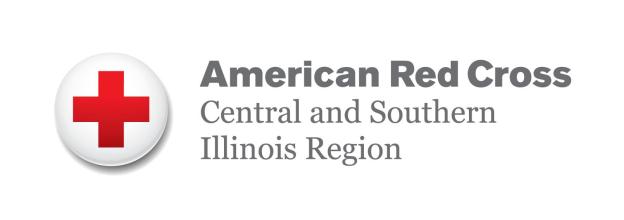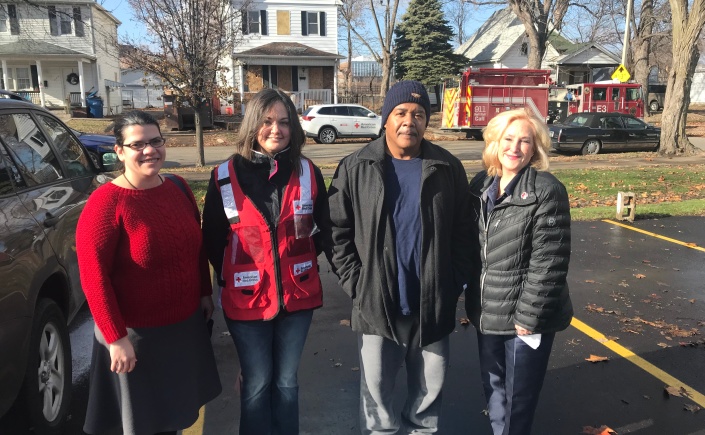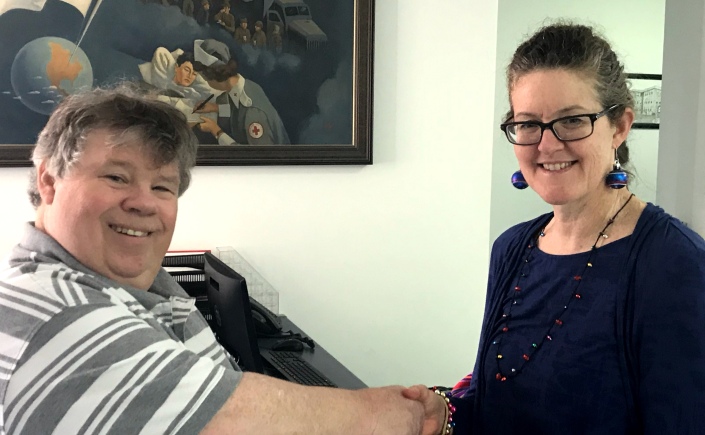By Brian DeLoche
For the American Red Cross
Peace and quiet. It’s what draws people to the rural countryside of west-central Illinois.
Where Greg and Darla Hobson live just off County Highway 21, outside the tiny hamlet of Valley City, that peace and quiet is usually disturbed only by the sound of an occasional passing car or truck, or depending on the time of year, the sound of tractors or combines in the nearby fields.
But on a warm Saturday afternoon (Dec. 1 no less), Darla heard an unusual sound outside her home. “It was a sound like I’d never heard before,” she said. “So, I opened the front door to see what was going on.”
That’s when her world was turned upside down. “As soon as I opened the door, I was picked up and blown across the room,” she said. “I grabbed onto a chair (an oversized living room chair) and for a while that chair and I were dancing in the air.”
“For a minute there, I thought she was going to be blown away,” Greg, who was seated in the living room putting on his shoes when the storm hit.
Their home, along with those of their sons on either side of their property had just been hit by one of the more than 20 tornadoes reported as a storm system ripped its way across Illinois in the mid-afternoon hours of Dec. 1.
For the Hobsons, there was no advanced warning. In the remote rural countryside, there are no warning sirens. “We knew there was supposed to be a chance of severe storms in the area that day. But we didn’t get any warning about a tornado,” Darla said.
“We were just getting ready to head into town (Griggsville) for our granddaughter’s birthday party. Our son Cody and his wife live right next door and they had already left. They called and said they had forgotten the ice cream for the party and asked us to stop in and pick it up for them. We were on the way to get it when the storm hit.”
As fate would have it, they never made it to their son’s house next door, and they didn’t make it to the party. The storm destroyed their son’s mobile home that stood less than 100 yards from their front door. “If we’d gotten out the door two minutes earlier, we would have been inside their house when the storm hit.”
The winds that destroyed her son’s house also did major damage to her own small, cozy home on the hill. The winds that tossed Darla across the room, blew the north wall out of her kitchen. “I still have no idea where my pots and pans are,” she said. The small microwave oven that sat in a built-in cabinet was ripped from its space and thrown into a field between her home and her son Brandon’s house. “Believe it or not, it still works,” she added as she pointed to the stainless steel appliance now back in its place.
“I can’t tell you much about what happened after that,” Mrs. Hobson said. “The next few hours were kind of a blur. But I remember somebody told me the Red Cross would be coming to help us out. I can’t tell you how long it was before they got here, but it was the same evening after the storm hit.”
“I can’t tell you their names, but they were so good to us,” she said. “They stopped at a grocery store in Barry, Il before they came here and they brought us groceries.”
“They stayed and talked with us for quite a while,” Darla said, “and that helped us calm down a bit.” All three Hobson families received Red Cross Direct Client Assistance.
Darla said she was amazed by the outpouring of support friends and neighbors have shown her family since the disaster. “It’s good to have friends, and have children who have friends,” she said with a smile, while dozens of people, many of whom brought machinery to help clean up the debris, worked on all three properties.
Darla said she will most likely use a portion of the immediate assistance funds she received from the Red Cross to buy a new vacuum cleaner. “There’s dirt and dust everywhere, in places like the inside of my kitchen cabinets. I don’t know if I’ll ever get done cleaning,” she said with a laugh.
Even though her home suffered major damage, the Hobsons still found time to laugh at the unusual things that managed to survive. A four foot tall Santa Claus figure made mostly of plastic and cloth stood at the front door of their home. The figure was tied to a post on the south side of the porch with only a couple pieces of yarn to hold it in place. After the storm, the statue was moved about 4-6 feet, and down a couple of steps and left still standing on the opposite side of the porch. Icicle lights and other Christmas decorations remained on the porch seemingly undamaged.
At her son Cody’s home, the storm destroyed the house, but left standing a plastic nutcracker statue held in place with screws on a porch railing. “It blew up my house, but somehow, the plastic nutcracker survived,” Cody said.
Though there have been a lot of tears so far, and more likely to come, Darla said, she will continue to look for a laugh wherever she can find it.
“You can’t let it get your sense of humor,” she said with a smile, “cause sometimes it’s all you’ve got.”












You must be logged in to post a comment.